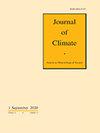Poleward migration of the latitude of maximum tropical cyclone intensity – forced or natural?
IF 4.8
2区 地球科学
Q1 METEOROLOGY & ATMOSPHERIC SCIENCES
引用次数: 0
Abstract
Past studies have shown a significant observed poleward trend in the latitude at which tropical cyclones reach their lifetime maximum intensity (LMI), especially in the Northwest Pacific basin. Given the brevity of the historical record, it remains difficult to separate the forced trend from internal variability of the climate system. A recently developed tropical cyclone downscaling model is used to downscale the Community Earth System Model 2 (CESM2) pre-industrial control simulation. It is found that the observed trend in the latitude at which tropical cyclones reach their LMI in the Northwest Pacific is very unlikely to be caused by internal variability. The same downscaling model is then used to downscale CESM2 simulations under historical forcing. The resulting trend distribution shows significant poleward migration of tropical cyclone LMI, even after regressing out both natural variability and the part of the forced warming pattern that projects onto natural variability. The results indicate that the observed poleward migration of the latitude at which tropical cyclones reach their LMI in the Northwest Pacific basin is likely to be, at least in part, forced. However, the magnitude of the projected poleward trend in climate models can be significantly modulated by the simulated spatial pattern of ocean warming. This highlights how discrepancies between models and observations, with regards to projected changes to the equatorial zonal sea-surface-temperature gradient under anthropogenic forcing, can lead to large uncertainties in projected changes to the LMI latitude of tropical cyclones.热带气旋最大强度纬度的极地迁移--被迫还是自然?
过去的研究表明,观测到的热带气旋达到其一生最大强度(LMI)的纬度有明显的极化趋势,尤其是在西北太平洋盆地。考虑到历史记录的短暂性,要将强迫趋势与气候系统的内部变异性区分开来仍然很困难。最近开发的热带气旋降尺度模型被用于降尺度模拟共同体地球系统模式 2(CESM2)的工业化前控制模拟。结果发现,观测到的热带气旋在西北太平洋达到其低纬度模式的纬度变化趋势不太可能是由内部变率引起的。然后使用同一降尺度模式对历史强迫下的 CESM2 模拟进行降尺度。由此得出的趋势分布显示,热带气旋 LMI 有明显的极地迁移,即使在回归出自然变率和投射到自然变率上的强迫变暖模式部分之后也是如此。结果表明,在西北太平洋海盆观测到的热带气旋达到其 LMI 的纬度向极地移动很可能是被迫的,至少部分是被迫的。然而,气候模式中预测的极地移动趋势的幅度会受到模拟的海洋变暖空间模式的显著影响。这突出表明,在人为强迫作用下,模式与观测之间在赤道地带性海面温度梯度预测变化方面的差异,会导致热带气旋低纬度中心纬度预测变化的巨大不确定性。
本文章由计算机程序翻译,如有差异,请以英文原文为准。
求助全文
约1分钟内获得全文
求助全文
来源期刊

Journal of Climate
地学-气象与大气科学
CiteScore
9.30
自引率
14.30%
发文量
490
审稿时长
7.5 months
期刊介绍:
The Journal of Climate (JCLI) (ISSN: 0894-8755; eISSN: 1520-0442) publishes research that advances basic understanding of the dynamics and physics of the climate system on large spatial scales, including variability of the atmosphere, oceans, land surface, and cryosphere; past, present, and projected future changes in the climate system; and climate simulation and prediction.
文献相关原料
| 公司名称 | 产品信息 | 采购帮参考价格 |
|---|
 求助内容:
求助内容: 应助结果提醒方式:
应助结果提醒方式:


